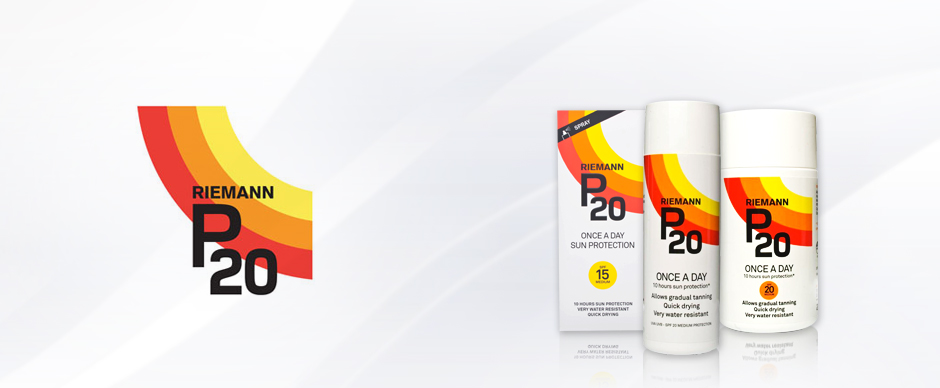Click & Collect now available!

From April to September, when the UV index exceeds 3, itís a good idea to follow prevailing sun advice and create good sun habits for you and your loved ones. To learn more about the UV index, different types of UV, how to look after your skin type, and P20ís top sun tips, check out our article below.
The UV index is a measurement of how intense the sunís rays are. The higher the number, the more intense the rays, and the more quickly you may burn. The Solar UV Index was designed to help you make an informed decision about how much time you should spend in the sun and what protection you should use.
This index predicts your risk of UV overexposure on a scale of 0 to 11+, with 0 being minimal risk and 11+ being very high risk. The forecast considers the sunís position in the sky, ozone levels in your region, cloud conditions, the levels of air pollution, ground altitude, and the amount of UV that is reflected off of surfaces. The result is based on Type 2 skin, which means fair skin that easily becomes red and rarely tans.
Itís important to know what the UV Index is for your area and to take the appropriate steps to protect yourself. UV Overexposure can cause sunburn, eye damage, premature skin ageing, and skin cancer. Additionally, if your hair is exposed to high levels of UV, it can become discoloured, dry, and brittle. You may experience hair breakage, split ends, thinning, or fizziness.
UV Rays are found naturally in sunlight and are split into two main categories: UVA and UVB. UVA rays penetrate deep into the skin while UVB rays are what cause you to burn. Itís not possible to totally block UVA and UVB rays, but it is possible to reduce their effects with dramatic results.
UVA
UVA rays can cause premature skin ageing like wrinkles and age spots. Even moderate sun exposure can lead to premature skin ageing. As well as this, UVA rays arenít stopped by glass, so weíre still being exposed to UVA rays while inside cars or near windows. Sun damaged skin has lines, hangs, is dry or rough, looks like leather, and is even yellowish or stained.
UVB
UVB rays are stronger than UVA rays. They are the primary cause of sunburn and skin cancer, but these rays can be blocked by glass.
All skin types react differently to the sun. Even darker skin types can be affected by UV rays. To avoid sunburn, redness, sun rash, and other long-term damage like wrinkles and skin cancer, it is important that you know your skin type and consider this when deciding how to behave in the sun. There are 6 basic skin types:
Skin Type 1
Hair Colour: Red / Blonde
Eyes: blue / green
Skin: Very pale, reddish
Will easily get sunburned skin, will never get a tanned skin
SPF: Use SPF 50 and then SPF 30
Skin Type 2
Hair Colour: Blond / red
Eyes: Blue, grey, green, hazel
Skin: Pale
Will easily get reddish skin, rarely get a tanned skin
SPF: Use SPF 30 or SPF 50
Skin Type 3
Hair Colour: Light Brown, Chestnut, Dark Blonde
Eyes: Brown, blue, grey, hazel
Skin: Light, Light Brown
Will sometimes red, and gradually tan
SPF: Use SPF 15, 20 or 30
Skin Type 4
Hair Colour: Dark brown
Eyes: Brown
Skin: Dark Brown
Being lightly tanned and rarely red
SPF: Use SPF 15
Skin Type 5
Hair Colour: Dark brown
Eyes: Brown
Skin: Dark Brown
Easily gets tanned skin and even darker
SPF: Use SPF 15
Skin Type 6
Hair Colour: Black
Eyes: Brown
Skin: Black
Gets a deep dark tan
SPF: Use SPF 15
Seek shade between 11 am and 3 pm
Stay out of the sun between the hours of 11 am and 3 pm, as this is when the sunís rays are the strongest. Even when using sun protection, you shouldnít stay in the sun too long. Itís also important to remember that sand, water, and snow reflect and amplify UV rays from the sun.
Wear light clothing and sunglasses
Protect your skin with light clothing, a wide brimmed hat, and sunglasses.
Use enough sunscreen
Always remember to apply enough sunscreen to achieve the protection stated on the product. An adult should use approx. 30-40 ml or a good handful for a full body coverage and about 20 ml for a child. If you apply less sunscreen, the sun protection factor and protection will decrease significantly.
Keep kids out of direct sunlight
Babies and young children should never be exposed to direct sunlight. Children should have extra protection against ultraviolet rays. You should use sunscreens with high protection factors, light clothes, and a sun hat. Setting your little one up with good habits can reduce their risk of sunburned skin, skin damage, and skin cancer.
Pack sun care that works as hard as you do when you head out into the great outdoors this spring and summer.
Whether youíre hitting the track, the trail, park, pool, or pitch, youíll need high-performing protection against the sunís rays that wonít let you down.
P20ís unique lightweight formulation is highly water-resistant, meaning that it keeps intact protection levels even after 4 x 20 minutes in the water. So, donít be slowed down by constant re-application of sun cream.
P20ís broad spectrum UV protection ensures you are fully protected when enjoying the outdoors. The range offers UVB protection as well as very high UVA protection that shields the skin from sun-related damage and premature aging. The UVA protection in P20 far exceeds EU recommendations and is therefore rated 5 out of 5 stars.
P20ís unique formulation is transparent and lightweight, meaning it is easily absorbed into the skin with no visible trace or sticky feel in just 15 minutes, meaning no hanging around! Whatís more, it contains no added fragrances or colorants.